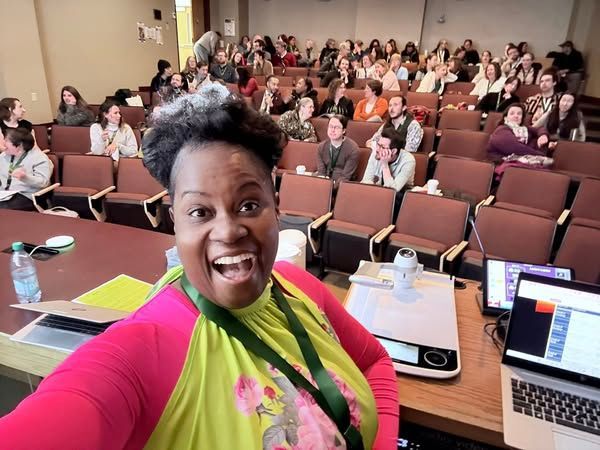Blog Layout
5 Tips for Eliminating School-to Prison Pipeline through Equitable Math Practices
India White • October 14, 2023
5 Tips to Eliminate School to Prison Pipeline!

5 Tips for Math Teachers to Combat School-to-Prison Pipeline with Equitable Math Practices
The school-to-prison pipeline is a disturbing phenomenon that disproportionately affects marginalized students, leading them from educational institutions to the criminal justice system. This usually happens from minor infractions that take place in the classroom that led to multiple unnecessary suspensions, and eventually causes learners to be expelled and enrolled in the juvenile system. For instance, there have been cases of students who were goofing off with friends, that were escorted out of their classroom by law enforcement as a result, although they did not pose a threat or harm to anyone. When these infractions add up on these students’ disciplinary records, it creates biases and has a negative psychological effect on each learner. ACLU mentions how this method of injustice has disproportionately affected students of diverse backgrounds, in particular, African American and Hispanic leaners.
Hence, as math teachers, we have a unique opportunity to challenge and disrupt this pipeline by implementing equitable math practices in our classrooms. By creating an inclusive and supportive learning environment, we can empower all students to succeed and break free from this unjust cycle!
Let’s talk about five essential tips for math teachers to diffuse school-to-prison pipeline practices with equitable math practices:
1. Cultivate a Positive Classroom Culture:
Creating a positive classroom culture is crucial for fostering an inclusive learning environment. This happens when there is cultural responsiveness, empathy, and strong relationships with students. Educators must be intentional at encouraging open dialogue, respect diverse perspectives, and actively listen to your students. When your students act out of character, or refuse to listen, take a moment to find out how to crack that shell and help them in their vulnerable state. Then, continue to establish clear expectations in a compassionate manner for behavior and ensure that all students feel safe and valued. By promoting a sense of belonging, you can help students develop a positive attitude towards math and education as a whole. Remember, you did not come to school to arrest students; you came to teach and support them as they evolve into productive citizens in society.
2. Incorporate Culturally Relevant Math:
Teachers should strive to make math relatable and culturally relevant to your students' lives. This can be accomplished as teachers integrate real-world examples, diverse mathematical contributions, and culturally significant contexts into your lessons. Choosing to celebrate learners by their cultural distinctions through prestigious leaders in their community and or highlighting neat facts about their ethnicity is key for connecting students to math. As mentioned in Ed Week, by connecting math to their experiences, you can engage students who may have previously felt disconnected from the subject and convince them that they belong.
Choose to see each learner for what they bring into the math space and give them a moment to have their voices empowered. These approaches help students see the relevance and applicability of math beyond the classroom, fostering a deeper understanding and appreciation for the subject.
3. Provide Differentiated Instruction:
Recognize that students have different learning styles, abilities, and backgrounds. Guess what? Sometimes, students just “don’t get it” like we got it! Hence, we have to put ourselves in their shoes, and take off the hat of judgment and choose to relate to their struggle in the math class. Some students have barriers of math anxiety, fear from their guardians of math due to years of pressure at home, and a lack of support in their communities. Hence, implementing differentiated instruction strategies to meet the diverse needs of your students is needed to make sure that every angle is covered and that students can flow metacognitively as they learn the math. Choose to offer various entry points to math problems, provide multiple representations, and encourage your students to engage in collaborative problem-solving. Further, choose to challenge your learners in the math and refuse to assume that they don’t want the more challenging problems because they “can’t do that level of math yet.” By tailoring your teaching to individual students, you can ensure that everyone has an opportunity to succeed and feel valued in the math classroom.
4. Address Implicit Bias: Implicit biases can unintentionally influence our interactions with students, perpetuating inequities. Sometimes, society can make educators feel that students from underserved communities cannot do math, and simply aren’t motivated or interested. However, this has been proven several times to be incorrect. Educators, choose to reflect on your own biases and actively work to address them. Work on your level of biases and see how you can reflect in a way that will help you address any unknown biases that have been detrimental to students. Allow yourself to challenge stereotypes and assumptions about students' mathematical abilities based on their race, gender, or socioeconomic status.
Begin treating all students with equal respect and provide equitable opportunities for participation and success. Remember, your character can be measured by how you treat people that you feel are less than you that cannot do anything for you! Hence, build your character and choose to show love and compassion and treat all students…. EQUALLY. Your students are trusting you to help them learn math, so keep the main thing the main thing! By being aware of and actively combating implicit biases, you can create a fair and inclusive learning environment.
5. Foster Student Agency and Empowerment:
Empower students to take ownership of their learning and make decisions about their mathematical journey. This can only be effectively done when teachers have developed a love and compassion for EACH learner and is truly an advocate for their students. Choose to encourage student voice and choice in the classroom, allowing them to explore topics of interest and solve problems in ways that resonate with them. Refuse to allow any form of dehumanization in your class, whether that’s students being exposed to racism, bullying, or hatred in any other form. Provide opportunities for students to collaborate, share their ideas, and engage in critical thinking. By fostering student agency
you can help students develop a sense of ownership and confidence in their mathematical abilities, reducing the likelihood of disengagement and negative outcomes.
Conclusion
As math teachers, we have a responsibility to challenge and dismantle the school-to-prison pipeline by implementing equitable math practices. Your kids need you to protect them, not sign them up for prison. By cultivating a positive classroom culture, incorporating culturally relevant math, providing differentiated instruction, addressing implicit bias, and fostering student agency, we can create an inclusive learning environment where all students can thrive. Let us commit to breaking the cycle and empowering our students to reach their full potential, both academically and personally. Together, we can make a difference and ensure that every student has an equitable opportunity to succeed in math and beyond.

By India White
•
April 8, 2025
Forgiveness: Walking in G.R.I.T. and Grace Forgiveness isn't for the faint of heart. It takes G.R.I.T.—Growth Mindset, Resilience, Self-Efficacy, and Time Management—to truly walk in forgiveness, especially when you've been wronged, mistreated, or misunderstood. But there's no greater example of gritty forgiveness than Jesus Himself. As He hung on the cross—suffering, bleeding, and abandoned—He didn’t curse His enemies. He didn’t demand justice in that moment. Instead, He looked toward heaven and said: “Father, forgive them, for they know not what they do” (Luke 23:34). Let that sink in. The very people who had betrayed, mocked, beaten, and crucified Him were the ones He forgave. And He did it in real time, while the pain was still fresh. That’s Great Resilience In Time. And as followers of Christ, we’re called to do the same. We’re called to forgive those who have: • Abused us—physically, emotionally, or spiritually • Slandered us behind our backs • Taken advantage of our kindness • Lied to us, hurt us, or wronged us in ways words can’t capture Forgiveness doesn’t mean the pain was okay. It doesn’t mean you return to harmful situations. But it does mean we release people into God’s hands. We stop carrying the weight of bitterness. And we trust that nobody gets by—God is just, but He is also merciful. “I did not come to call the righteous, but sinners to repentance.” — Luke 5:32 God operates in mercy—not because people always deserve it, but because His heart is for restoration. And if we want God to operate in mercy toward us, we must be willing to pray that same mercy over those who have hurt us. Hence, I want to share with you 5 Tips for Operating in Forgiveness Through G.R.I.T. and Grace: 1. Growth Mindset: Choose to Learn, Not Linger Instead of replaying the pain, ask God what He wants to teach you through it. Every hurt can become holy ground if we allow it to transform us instead of trap us. Forgiveness is a chance to grow. Even when you find yourself lingering in the memories and wondering "What if?", choose to use the moments of hurt as an opportunity to heal and evolve into a greater version of you. 2. Resilience: Bounce Back with God’s Strength Resilience doesn’t mean you don’t feel the pain—it means you refuse to let it define you. Forgiveness builds spiritual stamina. Each time you choose grace, you build strength in your spirit. The enemy wanted that trial, setback, dissapointment to cause you to give up on God and yourself. However, you must believe that no weapon formed against you shall propser. Never allow Satan to take away your song or your purpose, no matter the weapon or vessel he chooses to attack you through. 3. Self-Efficacy: Believe You Can Forgive with God’s Help Forgiveness may feel impossible—but with God, you can do all things. Self-efficacy is about believing in your ability to move forward. Speak life over yourself: "With God’s help, I can forgive." This is not always an easy process but you can do it! Choose to speak positively about your situation. Tell God that you forgive them and take moments to think about what Jesus must have felt at the cross as he died for you. Sometimes, we are made to emulate the light of Christ so that others will have HOPE. That means we must be willing to be curicifed at thier hands for the Glory of God. However, be encouraged, for the Lord will restore you. 4. Time Management: Don’t Waste Time on Bitterness Bitterness drains energy and time. Let forgiveness help you refocus your time and emotional energy toward purpose, healing, and joy. Steward your time wisely—it’s too precious to spend in bondage. Take time for self-care. Cry it out, seek therapy, have an outlet that will help you develop and heal and mature in a healthy fashion. Understand that all of us fall short; people will most likely dissapoint you, so flow in grace. 5. Great Resilience In Time: Forgive Even When It Still Hurts Forgiveness is often a process, not a one-time event. It requires Great Resilience In Time —the ability to keep choosing grace, even when the pain is fresh. Jesus forgave while He was still on the cross. We, too, can learn to forgive even while healing. Through your forgiveness you'll find revelation that will bring your closer to your heavenly Father. Forgiveness is one of the greatest gifts you can give—to others, yes, but also to yourself. It frees your heart. It releases your soul. It makes space for God to heal what others tried to break. Jesus didn’t wait for an apology. He forgave in real time—with G.R.I.T. and grace. So today, let’s strive to do the same. Let’s live with: • A growth mindset that says, “God can use even this.” • Resilience that says, “I will not be broken.” • Self-efficacy that says, “I can do this with God.” • Time management that says, “I will not waste one more second holding a grudge.” Let’s walk in Great Resilience In Time and extend the same mercy we so desperately need. Because forgiveness isn’t weakness. It’s worship. So, wipe you tears, forgive, reset, start over, and thrive through G.R.I.T. and Grace. Love, India Want more? Visit www.india-white.com to schedule a meeting or book me for an event. Want a copy of the Grit Workbook for Clergy (Pastors) Click here!

By India White
•
April 3, 2025
### April Newsletter: A Month of Grit and Growth April is here, and it’s shaping up to be an exciting month filled with powerful opportunities to build grit, inspire educators, and impact students. From conferences to new resources, I’m thrilled to share what’s happening this month and how you can get involved. Speaking at MCTM’s Annual Math Conference in Minnesota I’m honored to present at the Minnesota Council of Teachers of Mathematics Annual Conference this month, where I’ll be diving into how to create a Gritty Thinking Classroom. In this session, we’ll explore how the G.R.I.T. framework aligns with Peter Liljedahl’s Building Thinking Classrooms, helping educators develop a culture of perseverance, resilience, and self-efficacy in their math students. If you’re attending, I’d love to connect and discuss ways to empower students through productive struggle. G.R.I.T. Workbooks and Resources The G.R.I.T. Workbook series continues to grow, providing teachers, students, and parents with practical tools to develop growth mindset, resilience, and time management. Whether you’re looking to strengthen your own grit or help students push through challenges, these workbooks offer actionable strategies to build confidence and perseverance. G.R.I.T. Online Courses and Masterclass For those looking to take a deeper dive into grit, we’re rolling out G.R.I.T. online courses and mini-workshops designed to help educators and leaders implement grit-based strategies in their schools and classrooms. Stay tuned for our Masterclass, which will provide an interactive learning experience on how to cultivate grit in both personal and professional settings. G.R.I.T. Podcast: Conversations That Inspire The G.R.I.T. Podcast continues to feature insightful conversations with educators, leaders, and changemakers who are passionate about building perseverance and resilience. Each episode offers motivation and strategies to help you stay committed to your goals and push through challenges. Be sure to tune in for inspiring discussions that fuel personal and academic growth. Stay Connected If you’re looking for more ways to engage with the G.R.I.T. movement, be sure to check out: - www.india-white.com – Explore my work, speaking engagements, and resources - www.gritacademy.us – Learn about G.R.I.T. Academy, where we help students and educators develop the skills they need to thrive This month is all about embracing grit, growth, and resilience. Whether through conferences, podcasts, or online learning, I’m excited to continue this journey with you. Let’s keep pushing forward and building a culture of perseverance together. Stay gritty and keep striving for greatness!

By India White
•
April 3, 2025
Excited to Speak at MCTM’s Annual Math Conference: Building a Gritty Thinking Classroom! I can’t wait to present at MCTM’s Annual Math Conference this April in Minnesota. This opportunity is truly special because I’ll be diving into two of my passions—grit and Building Thinking Classrooms—to help educators create Gritty Thinking Classrooms that foster resilience, problem-solving, and perseverance in students. Why Grit Matters in the Math Classroom Math is not just about numbers and equations; it’s about persistence, self-efficacy, and growth mindset. So many students struggle with productive struggle, but when we intentionally build grit, they learn how to push through challenges rather than give up. By implementing Dr. India White’s G.R.I.T. framework, we help students: - Develop a growth mindset - Build resilience in problem-solving - Strengthen self-efficacy - Improve time management and perseverance Connecting Grit with Building Thinking Classrooms Peter Liljedahl’s Building Thinking Classrooms has transformed the way we engage students in math learning. When we merge BTC structures with grit, we create an environment where students: - Tackle challenging problems head-on - Collaborate with peers to build understanding - Learn to embrace struggle as part of growth - Develop confidence in their ability to succeed In my session, we’ll explore how BTC’s 14 elements align with grit and how teachers can create a culture of perseverance in their classrooms. See You in Minnesota! If you’re attending MCTM’s Annual Math Conference, I’d love to connect. Let’s talk about how to empower students to think, struggle, and grow. Together, we can build Gritty Thinking Classrooms that transform how students learn and engage with mathematics. Let’s get gritty! See you soon in Minnesota!

By India White
•
March 25, 2025
🌟 Excited to share my VCTM recap video! 🎥 Join me as I engage with teachers during my keynote, discussing strategies to best support our 8th grade math students. Together, we can make a difference! 💪📚 Check it out and let’s keep the conversation going! #drindiawhite #nctm #ncsm #vctm #vermont #nabse #naacp #education #doe

By India White
•
March 25, 2025
Reflection on The Power of Grit Keynote to Vermont Teachers Speaking to the dedicated educators of Vermont about the Power of Grit was an inspiring and reaffirming experience. As I shared the pillars of grit—Growth Mindset, Resilience, Time Management, and Self-Efficacy—it was evident that these concepts resonated deeply with the teachers in the room. Their commitment to fostering perseverance and confidence in their students was both heartening and energizing. Throughout the keynote, I emphasized the transformative role of a growth mindset—how students who embrace challenges and see effort as a path to mastery are more likely to persist through difficulties. I could see educators nodding in agreement as they reflected on their own students' struggles and triumphs. Encouraging students to reframe failure as a learning opportunity is a crucial shift that builds not just better mathematicians, writers, and thinkers but also more resilient individuals. Resilience was another cornerstone of the discussion. I shared stories and strategies to help students push past obstacles and develop the endurance needed to navigate academic and personal challenges. The engagement in the room reaffirmed that teachers, too, are models of resilience, especially in today’s educational climate. One of the most practical elements of the keynote focused on time management—helping students (and educators) break down overwhelming tasks, set realistic goals, and prioritize effectively. The response to this section showed that time management remains a crucial skill, not only for students learning to structure their studies but also for teachers juggling multiple responsibilities. Finally, we explored the power of self-efficacy, that deep-seated belief that one’s efforts lead to success. We discussed ways to cultivate this mindset in students through intentional feedback, scaffolding, and celebrating small wins. Seeing the teachers reflect on how they could implement these strategies in their classrooms was incredibly rewarding. This keynote reaffirmed my belief that grit is not just a personal trait—it’s a culture that educators can foster in their classrooms, schools, and communities. Vermont’s educators left the session with new insights, actionable strategies, and a renewed commitment to equipping students with the perseverance and confidence needed for success. I am grateful for the opportunity to share this message, and I look forward to seeing the impact of their work in cultivating grit across the state. Thanks Vermont Rockstars. Stay gritty!

By India White
•
March 25, 2025
✨ I had a phenomenal time speaking for the VCTM Rockstars in Vermont! We dove into how to reach all learners and stay motivated through grit. 💪 I can't wait to see the results from the grit assessment and framework! Stay gritty, y’all! 🌟 #drindiawhite #vctm #vermont #grit #educators #math

By India White
•
March 18, 2025
🌟 Super excited to announce that I’ll be the keynote speaker at the VCTM Annual Conference in beautiful Vermont! 🎉 Huge thanks to the amazing VCTM rockstars for this incredible opportunity! Let’s dive into the power of grit together! 💪✨ I can’t wait to share insights and connect with fellow educators, students, and math enthusiasts. Join us by registering below: https://vctm.wildapricot.org/event-5950535 Let’s make this an unforgettable experience! #drindiawhite #grit #tedx #vctm #teachers #students #math (I don’t own music copyright)

By India White
•
March 18, 2025
Join us on the Let's Get Gritty Podcast with Dr. India White, featuring special guest Heidi Diercks, a retired educator, and life coach! Check out Heidi's coaching nuggets here :chrome-extension://efaidnbmnnnibpcajpcglclefindmkaj/https://mail.google.com/mail/u/0?ui=2&ik=89c50e1d3a&attid=0.1&permmsgid=msg-f:1826500568311074330&th=19590896f43b0e1a&view=att&zw&disp=inline&acrobatPromotionSource=GmailNativeViewer Watch on Spotify: https://creators.spotify.com/.../Lets-Get-Gritty-Podcast... #drindiawhite #grit #tedx #lifecoach #education

By India White
•
March 18, 2025
🌟 Super grateful to announce that I’ve been selected to speak at FCTM this year! 🎉 Let’s dive into the topic of grit and its importance in education! 💪✨ Be sure to register by visiting their website. A huge thank you to the FCTM leaders for this incredible opportunity! 🙌 #DrIndiaWhite #Grit #TEDx #Math #Educators #Teachers #Students #FCTM #NCTM #NCSM
Contact Us
Thank you for contacting us.
We will get back to you as soon as possible.
We will get back to you as soon as possible.
Oops, there was an error sending your message.
Please try again later.
Please try again later.
© 2025
India White, All Rights Reserved. Powered By Automation Links
Terms of Us | Privacy Policy | About
